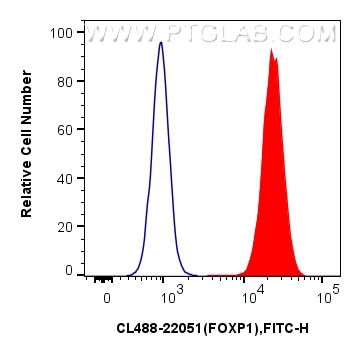Validation Data Gallery
Tested Applications
| Positive FC (Intra) detected in | Jurkat cells |
Recommended dilution
| Application | Dilution |
|---|---|
| Flow Cytometry (FC) (INTRA) | FC (INTRA) : 0.40 ug per 10^6 cells in a 100 µl suspension |
| It is recommended that this reagent should be titrated in each testing system to obtain optimal results. | |
| Sample-dependent, Check data in validation data gallery. | |
Product Information
CL488-22051 targets FOXP1 in FC (Intra) applications and shows reactivity with human, mouse, rat samples.
| Tested Reactivity | human, mouse, rat |
| Host / Isotype | Rabbit / IgG |
| Class | Polyclonal |
| Type | Antibody |
| Immunogen |
CatNo: Ag17045 Product name: Recombinant human FOXP1 protein Source: e coli.-derived, PGEX-4T Tag: GST Domain: 349-457 aa of BC131720 Sequence: QLELQLAKDKERLQAMMTHLHVKSTEPKAAPQPLNLVSSVTLSKSASEASPQSLPHTPTTPTAPLTPVTQGPSVITTTSMHTVGPIRRRYSDKYNVPISSADIAQNQEF 相同性解析による交差性が予測される生物種 |
| Full Name | forkhead box P1 |
| Calculated molecular weight | 677 aa, 75 kDa |
| Observed molecular weight | 50 kDa, 60-65 kDa, 85 kDa |
| GenBank accession number | BC131720 |
| Gene Symbol | FOXP1 |
| Gene ID (NCBI) | 27086 |
| RRID | AB_3672739 |
| Conjugate | CoraLite® Plus 488 Fluorescent Dye |
| Excitation/Emission maxima wavelengths | 493 nm / 522 nm |
| Form | |
| Form | Liquid |
| Purification Method | Antigen Affinity Purified |
| UNIPROT ID | Q9H334 |
| Storage Buffer | PBS with 50% glycerol, 0.05% Proclin300, 0.5% BSA{{ptg:BufferTemp}}7.3 |
| Storage Conditions | Store at -20°C. Avoid exposure to light. Stable for one year after shipment. Aliquoting is unnecessary for -20oC storage. |
Background Information
FOXP1, also known as Mac-1-regulated forkhead, is a 677 amino acid protein, which forms homodimers and heterodimers with FOXP2 and FOXP4 (PubMed:25027557). Dimerization is required for DNA-binding. FOXP1 has an important function in neuronal development.9 Mutations of its gene, FOXP1, located on chromosome 3p14.1,7 can result in the development of autism spectrum disorder, intellectual disability, speech and language deficits as well as motor development delay. FOXP1 is also engaged in lung and esophagus morphogenesis, as well as in B-cell development.7,10 The widely researched role of FOXP1 in carcinogenesis is of great importance, although still unclear to some extent. FOXP1 exists some isoforms with MV 75-77 kDa, 65-67 kDa, 12 kDa.

